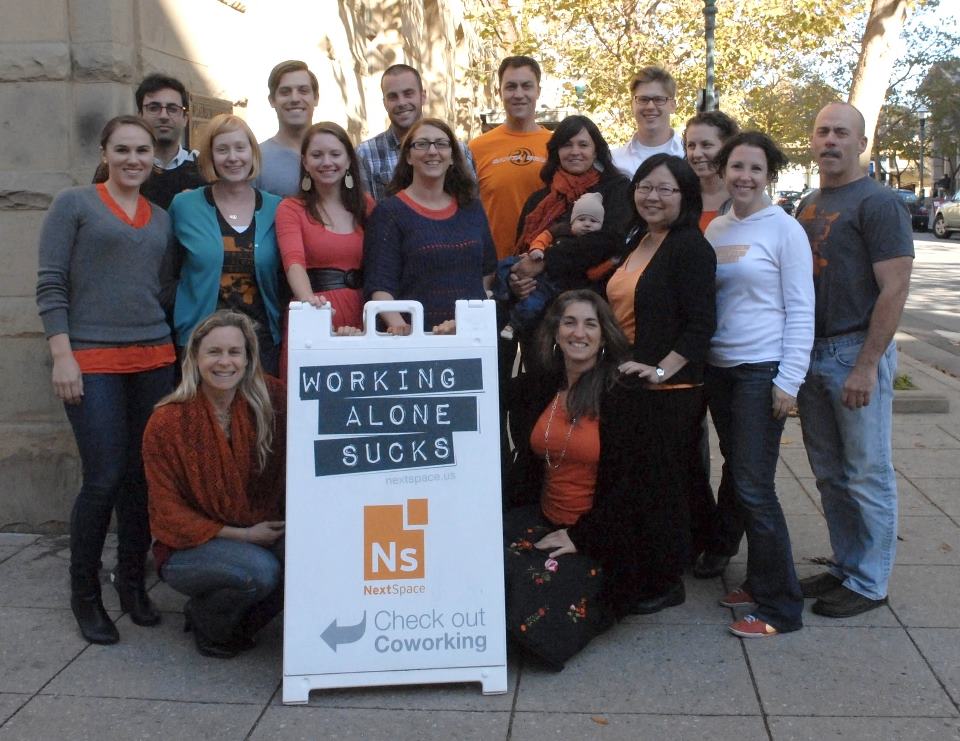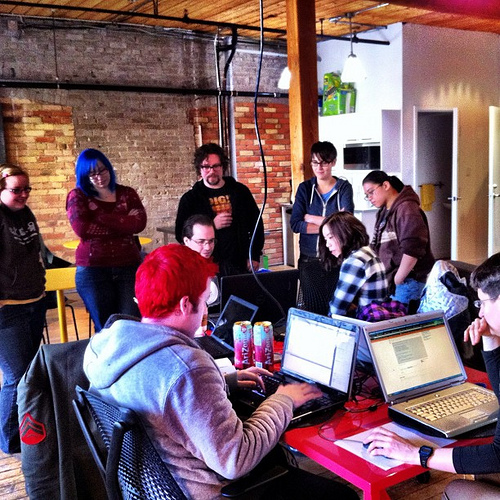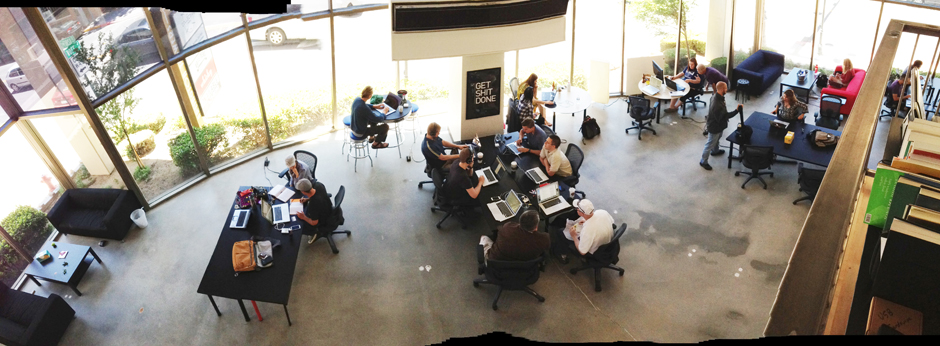With well over 2,000 coworking spaces now operational worldwide and new spaces opening their doors almost every day, it is imperative that owners and community managers set high standards. This is important not only for the fulfillment of the space's mission and the delivery of a positive coworking experience, but also the longevity of the business.
To help, we’ve compiled a ten-step guide to the ‘perfect’ coworking space, based on our interactions with coworking space operators and users across Australia, as well as insights borrowed from influencers and thought leaders in the space of collaborative consumption.
While everybody’s definition of perfect may vary, the careful execution of the following steps is almost certain to result in a sustainable and successful coworking space.
Step 1 – Identify Your Market

Your market dictates everything you do. Your name, logo, website, location, fitout…basically, everything that makes up your brand.
Don’t try to be everything to everyone or you will struggle to deliver a consistent marketing message. If you don’t focus on a particular segment, you’ll wind up having no appeal to almost the entire market. Get to know your prospective audience well, and pick a niche market based on factors such as industry, business maturity, the size of the business, location, age, culture and values and of course, demand prospects.
“While it’s good to push some people’s boundaries, it’s also true that we have very individual ways of working and we should feel comfortable to gravitate to the community that suits us best” says Collaborative Lab’s Lauren Anderson.
Decide if you’ll use an open door policy or review applications in order to maintain community consistency. Businesses at the same stage of the business maturity lifecycle will experience similar growing pains, and working side by side will allow for shared insights and collaboration. The same cannot be said about businesses in vastly different stages.
If your coworking space loses sight of the target market (or fails to define it before opening), its identity is also lost. Without definition, you run the risk of becoming just another shared office instead of a community built on consistent values and philosophies that keeps users coming back.
This is not to say that you can’t have people from radically different backgrounds working in the same space – in fact, this is a significant benefit of coworking, so long as they complement each other. The classic example is of developers work alongside designers and online marketers. In this case, the common theme and dominant flavor of the place would be of early stage tech startups or online businesses.
Step 2 – Location, Location

As with buying a home, location is king when it comes to coworking spaces.
Once you’ve identified your market, you should have a better idea of where to set up. Does the hustle and bustle of the central business district (CBD) make sense or should you be in a quieter place to nurture those in the creative domain? Maybe your market is based on geography alone and so it makes sense to be as centrally-located as possible.
Whatever the case, ensure that the location selected is the best fit for your market’s needs and workstyle.
Speaking of market needs, now is a good time to assess whether your prospective location is ready for coworking. Consider factors such as competing spaces in the area (or lack thereof), whether there is a high instance of people working from cafes, and whether people are prepared to provide financial support for your coworking space.
There’s not much point building a coworking space with all the bells and whistles if demand is unsustainable.
If possible, ensure public transport is nearby (car parking is a big bonus but not really practical or affordable in most CBD areas) and that the coworking space is relatively close to a coworker’s playground – think restaurants, coffee shops, retail stores and bars.
A recent DeskMag survey found that for 81 percent of coworkers, having snack bars and restaurants nearby is highly important, while nearly two thirds want a supermarket in the vicinity, so don’t be fooled into thinking that people only want a place to work.
As for the venue itself, make sure you have the right to alter the look and feel of the venue before signing the lease. Ample lighting (preferably natural) and plentiful windows help productivity and promote positive mood. A nearby park, river or beach view is an even bigger bonus!
Step 3 – Interior Design

The first thing that prospective users notice when entering your coworking space is essentially the interior design and furnishings. Make no mistake, within a few seconds they would have made up their mind about how they feel about the space–without working there or speaking to a single member!
It is critical for the fitout to reflect the space’s core principles and target market’s values. Doing so optimises these few decision making seconds and leaves the prospect wanting to belong.
Interior design also goes a long way toward establishing the work environment, managing member moods and attitudes, and creating opportunities for conversation and collaboration. It can be the difference between a drab silo ridden quiet environment and an open, dynamic and energetic environment where people quickly become both friends and business associates.
Consider a mix of open plan temporary ‘hotdesks’, permanent desks, brainstorming spots, private team spaces, and quiet spaces where people can get away from the ‘floor’ and do their strategic thinking, as well as a conference room, which is a draw for those who see clients on a regular basis.
Breakout areas are meant to encourage conversation and relationship building while open plan areas are meant to encourage discussion and collaboration.
Artwork is important – it can be funky, post-modern, conservative…whatever. It all depends on your members. In all cases though, it should inspire and not distract. Not sure? Poll the community. They’ll tell you what they like and what they don’t.
One thing that is often overlooked when setting up a space is acoustics. Bad acoustics can result in sound traveling from one side of the room to the other and will have your space sounding like a boiler room straight out of The Wolf Of Wall Street. You may need to consult a professional to determine how best to keep noise to a minimum.
Stephen Frey, of Design Cultivation, says it is worth considering factors such as sound deadening floor coverings, ceiling treatments, sound clouds, wall panels, individual work areas and varying ceiling and wall surface angles. “Generally, consider doing a combination of solutions and trying out different ideas, tuning your space over time”, he says.
When it comes to interior design, you’re only limited by your (and maybe your interior decorator’s, should you choose to outsource) imagination.
Have fun with it but never lose sight of the people you’re building it for, your members. There is such thing as the law of diminishing returns.
Step 4 – Branding

Coworking isn’t only about the space. Your name, logo, marketing materials and digital identity say a lot about the community and its members.
Shakespeare taught us that a rose by any other name would smell just as sweet. That may be true, but you can’t smell the rose unless you venture into the garden, so a less than engaging name may have your target market searching elsewhere and never getting close enough to catch the scent. Your name dictates your logo which together may influence people’s initial perceptions of your brand. This takes us to your online identity.
As the primary first point of contact with your business, a high quality website (and social media accounts) that reflects a positive brand is essential. When aligned with your chosen market these assets will attract not only members, but the right ones. And don’t forget pictures of the community in action: images of an empty space are less than thrilling for prospective members.
On social media, if you’re using it (which you should) don’t just post, be sure to engage!
Finally, think about how advertising reflects on your brand. While websites like Gumtree or Craigslist are littered with office space listings, they’re not exactly targeted to your audience. There are many pure-play shared office space platforms such as LiquidSpace in the United States, HotDesk in Australia and Seats2Meet in Europe, among others. While not absolutely critical, advertising where your market searches is an advantage.
Step 5 – Community and Culture

Ask anybody in the know what the difference between a coworking space and a mere shared office space is and the answer will always be community. There’s more to opening and running a coworking space than just opening the doors of a building full of desks, ergonomic chairs and a wifi connection.
The key to attracting people may lie in branding, but the key to retention is in community. We are all human beings and we all want to be liked so it’s important that steps are taken to foster an inclusive community built on common values, cultural traits and a set of non-overbearing house rules.
Photo boards featuring space members, regular newsletters advising of new developments in the space, special member only offers, educational opportunities and remote working tools are even better.
Engage with members on social media and use social media as a platform to promote events and member businesses as well.
Friday night drinks and pizza (a staple in tech startup coworking spaces), beer fridges, the occasional lunch and alternative currencies are great ways to build lasting relationships between coworking space members.
If you’re pressed for time but have the resources, consider hiring a community manager. They can be onsite, curating and growing the community culture even when you can’t be there.
Step 6 – Events and Education

Aside from being an added income stream, events help to market your space to others in the community who might not immediately see themselves as member material.
Even when hosted by those outside your membership, the nature of events should align with your brand and be enticing to your market.
For example, if your coworking space focuses on public practice professional services such as accountants, lawyers, or bookkeepers, topics such as ‘How to maximize your tax return’ serve to build your brand further and solidify your reputation as the public practice coworking space.
Let members attend for free as a membership value-add and encourage them to organize their own events. The resident tax consultant will not only boost his public speaking credentials by holding a workshop, but could also generate additional leads and customers. Another value add.
Whatever the event and whoever the organizer, be sure to set aside a 30 to 60 minute block of time after the presentation for mingling and casual conversation. This is where the real magic happens!
Education also extends beyond workshops. Your website should include a blog where you (and members) can post on topics such as efficiency, collaboration, and remote working tools. This infor can then be repurposed on social media accounts and in newsletters.
A lending library, whether digital or hardcopy, of books, journals, hardware and other general value adding resources is also very useful, and helps to transform your space into an all-purpose sharing hub.
Step 7 – Seamless Sign-Up, Access and Billing Management

In the digital age, people don’t want to deal with hardcopy paperwork, manual payments, limited access to the coworking space, or wireless internet issues.
While not all technologies in this space are mature yet, there are a number of software offerings designed to make managing a space, as well as being a member of a space, easier.
From managing user registrations and access to the space to online meeting room bookings, invoice generation, direct debit of member payments and the subsequent provision of receipts, tools such as Cobot can help make your job easier. Plus, you’ll save some trees along the way!
Step Eight – Music

While background music may be a definite no-no for many spaces, depending on the market you chose way back in Step One, music is the norm in a lot of spaces. And remember, if you’re not sure, ask your community for input!
Like gyms, whose business model has been compared to coworking spaces, not everybody will enjoy the music being played, resulting in a number of headphones being visible at any given time. Others will appreciate the background music, without the need to stuff their earlobes with plastic and disconnect from the world around them.
Introduce a Bluetooth ready speaker system, invite each member to contribute songs to a Spotify playlist and keep the volume to an appropriate level. Again, this inclusiveness goes back to creating a community and while there may be some ribbing of each other’s musical tastes, people should be mature enough to not let it get in the way of getting work done.
Step 9 – Amenities

As alluded to in previous steps, coworkers will expect a minimum set of amenities at most spaces.
This includes, but may not be limited to ergonomic chairs and desks, wireless internet, printer and copier access, basic kitchen facilities, a coffee machine, showers, lockers, change rooms and lavatories.
Markets dictate the space but don’t be afraid to go the extra mile and invest in things that are going to make life easier for your members. Nerf guns optional.
Step 10 – Pricing and Flexibility
Coworking is meant to be flexible…and affordable.
While people enjoy the collaboration and community that comes with coworking, the most important factor is often price and convenience. The coworking business model is particularly attractive to small businesses that can't afford inflexible long-term commercial real estate leases, and has been spurred on by technological advances in remote working technologies (affordable laptops, mobile phones + wireless internet).
That's why it's important to create a variety of packages to suit different member needs. From casual drop-ins to one, three and seven day a week passes, be flexible. Also offer 24-7 access where possible.
Can’t decide what to charge? Assess the membership fees of other spaces, and combine that information with the knowledge you’ve gained about the target market, location, fitout, community and overall brand. This will help you determine a reasonable price point for member packages as well as short-term daily, weekly and monthly bookings.
Incentivize teams with discounted team packages and permit coworkers the ability to suspend or cancel their membership (with an agreed notice period so you can best manage your cashflow).
Consider whether or not you’ll charge for meeting room use and whether this will form part of user packages or be an a la carte service.
Is the space is relatively empty on Mondays and Fridays? Consider offering a cheap drop-in pass for those days.
There are so many ways to play this but ultimately, it should serve to keep you in business by way of a community that is happy to exchange cash for the benefits of community membership.
Images via Reno Collective, emiliokuffer, Creative Density, ThincSavannah, New Work City, jenniewoo, PAX Coworking, Cobot, digitpedia, the office, Cohere Community









